Taxation Law 2: Analysis of Taxation for ABC Sports and John
VerifiedAdded on 2021/06/14
|13
|3580
|38
Report
AI Summary
This taxation law assignment analyzes the tax implications for ABC Sports Pty Ltd and John. It examines the assessability of receipts and deductibility of expenses, considering relevant legislation such as the ITAA 1997 and FBTAA 1986. The report addresses the tax consequences of compensation received from contract cancellations, relocation expenses, salary, superannuation, school fees, car fringe benefits, and membership fees. Furthermore, it assesses capital gains tax implications from the sale of a yacht and a horse, considering the application of personal use asset rules and relevant case law such as Californian Oil Products Ltd v Federal Commissioner of Taxation and Scott v Commissioner of Taxation. The analysis covers ordinary income, capital expenditure, and fringe benefits, providing a comprehensive overview of the tax consequences for both the company and the individual, John.
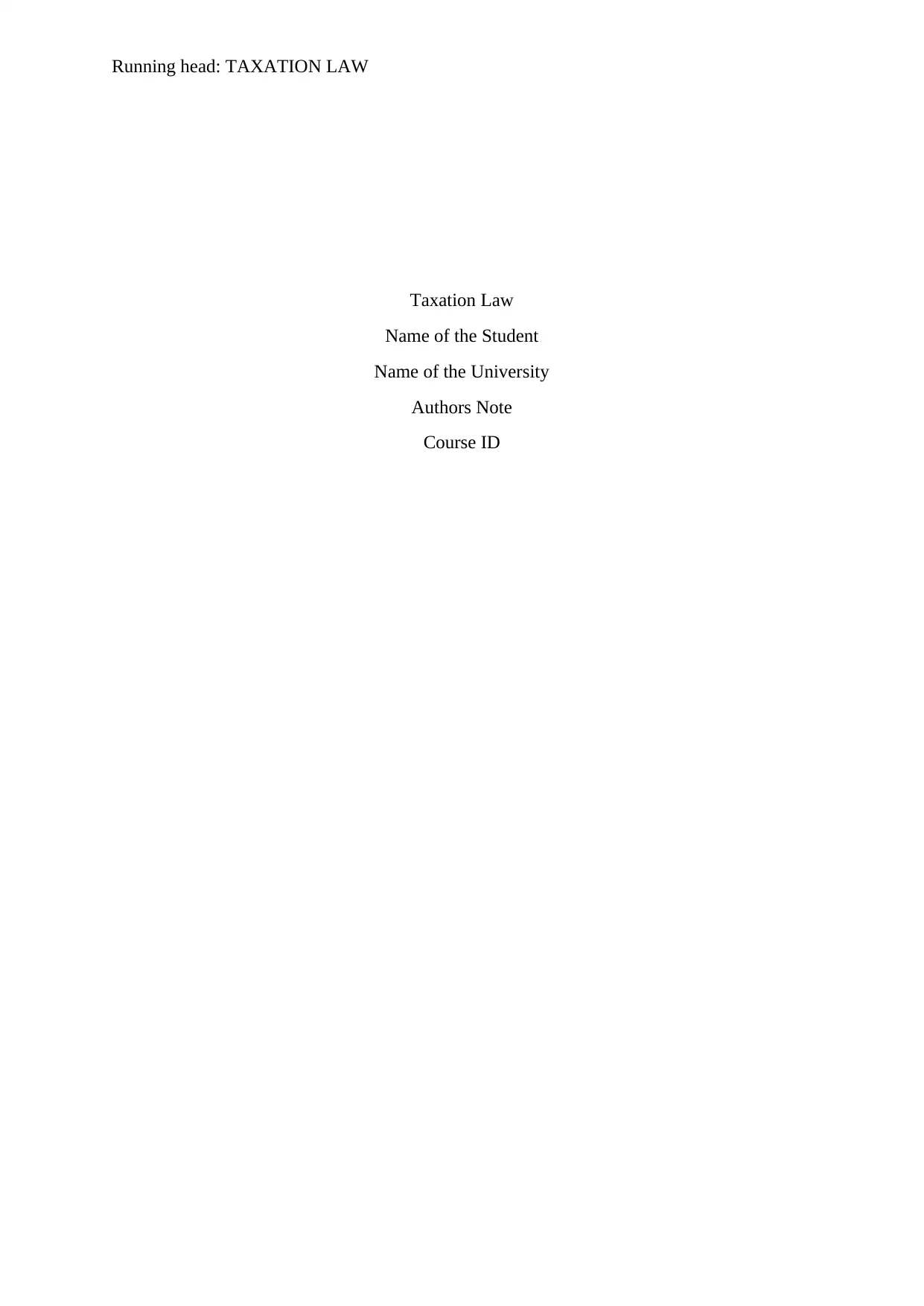
Running head: TAXATION LAW
Taxation Law
Name of the Student
Name of the University
Authors Note
Course ID
Taxation Law
Name of the Student
Name of the University
Authors Note
Course ID
Paraphrase This Document
Need a fresh take? Get an instant paraphrase of this document with our AI Paraphraser
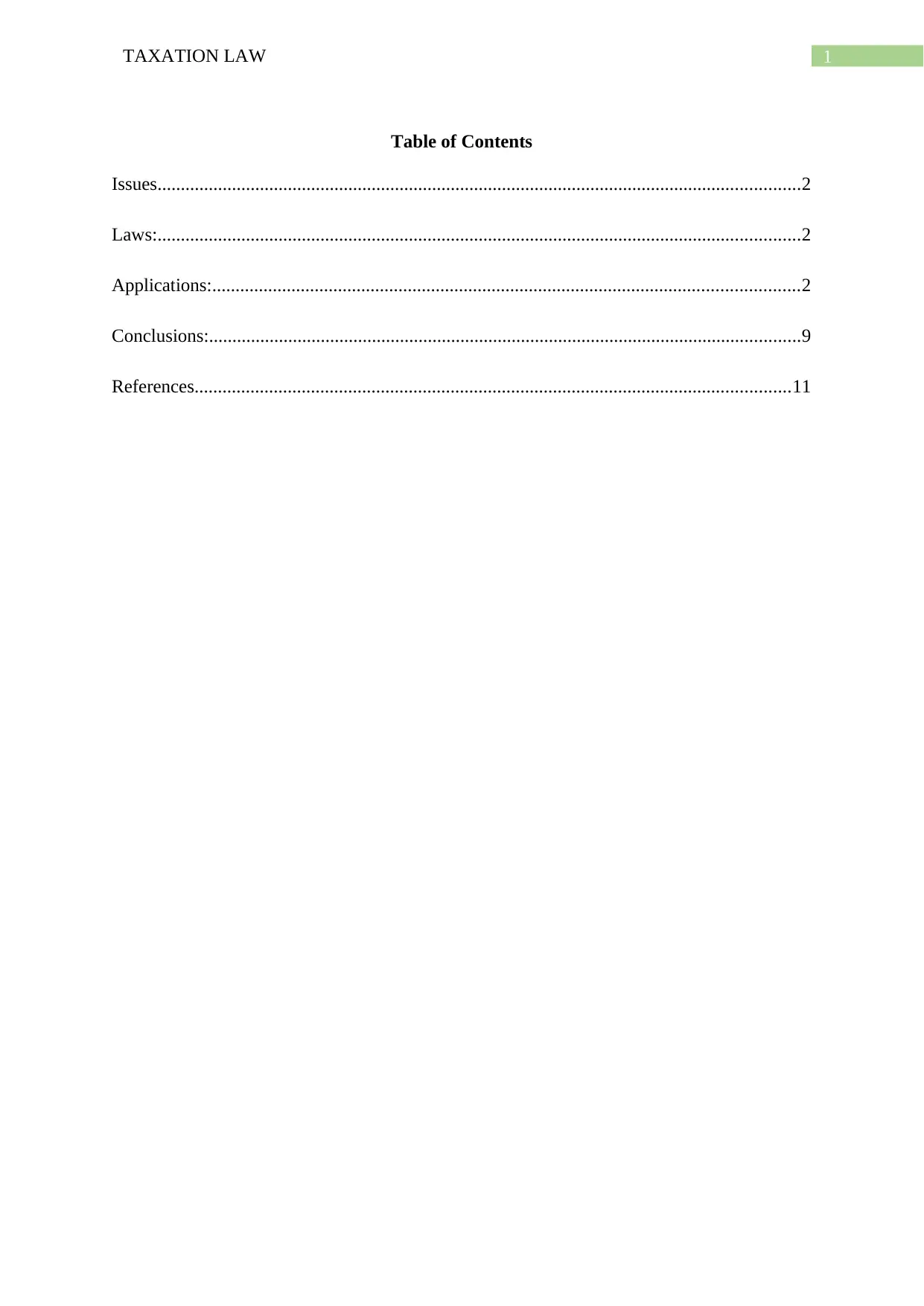
1TAXATION LAW
Table of Contents
Issues..........................................................................................................................................2
Laws:..........................................................................................................................................2
Applications:..............................................................................................................................2
Conclusions:...............................................................................................................................9
References................................................................................................................................11
Table of Contents
Issues..........................................................................................................................................2
Laws:..........................................................................................................................................2
Applications:..............................................................................................................................2
Conclusions:...............................................................................................................................9
References................................................................................................................................11
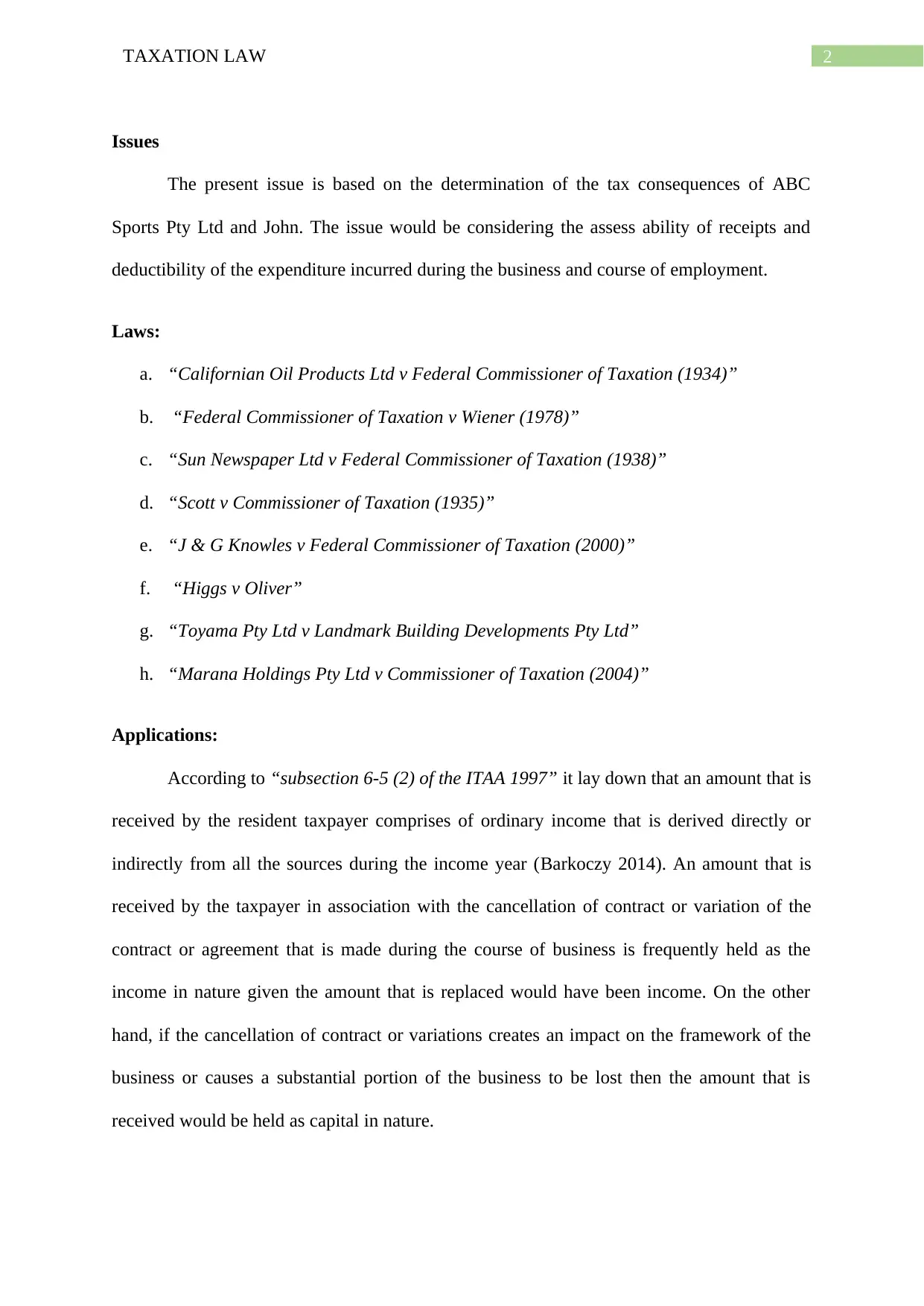
2TAXATION LAW
Issues
The present issue is based on the determination of the tax consequences of ABC
Sports Pty Ltd and John. The issue would be considering the assess ability of receipts and
deductibility of the expenditure incurred during the business and course of employment.
Laws:
a. “Californian Oil Products Ltd v Federal Commissioner of Taxation (1934)”
b. “Federal Commissioner of Taxation v Wiener (1978)”
c. “Sun Newspaper Ltd v Federal Commissioner of Taxation (1938)”
d. “Scott v Commissioner of Taxation (1935)”
e. “J & G Knowles v Federal Commissioner of Taxation (2000)”
f. “Higgs v Oliver”
g. “Toyama Pty Ltd v Landmark Building Developments Pty Ltd”
h. “Marana Holdings Pty Ltd v Commissioner of Taxation (2004)”
Applications:
According to “subsection 6-5 (2) of the ITAA 1997” it lay down that an amount that is
received by the resident taxpayer comprises of ordinary income that is derived directly or
indirectly from all the sources during the income year (Barkoczy 2014). An amount that is
received by the taxpayer in association with the cancellation of contract or variation of the
contract or agreement that is made during the course of business is frequently held as the
income in nature given the amount that is replaced would have been income. On the other
hand, if the cancellation of contract or variations creates an impact on the framework of the
business or causes a substantial portion of the business to be lost then the amount that is
received would be held as capital in nature.
Issues
The present issue is based on the determination of the tax consequences of ABC
Sports Pty Ltd and John. The issue would be considering the assess ability of receipts and
deductibility of the expenditure incurred during the business and course of employment.
Laws:
a. “Californian Oil Products Ltd v Federal Commissioner of Taxation (1934)”
b. “Federal Commissioner of Taxation v Wiener (1978)”
c. “Sun Newspaper Ltd v Federal Commissioner of Taxation (1938)”
d. “Scott v Commissioner of Taxation (1935)”
e. “J & G Knowles v Federal Commissioner of Taxation (2000)”
f. “Higgs v Oliver”
g. “Toyama Pty Ltd v Landmark Building Developments Pty Ltd”
h. “Marana Holdings Pty Ltd v Commissioner of Taxation (2004)”
Applications:
According to “subsection 6-5 (2) of the ITAA 1997” it lay down that an amount that is
received by the resident taxpayer comprises of ordinary income that is derived directly or
indirectly from all the sources during the income year (Barkoczy 2014). An amount that is
received by the taxpayer in association with the cancellation of contract or variation of the
contract or agreement that is made during the course of business is frequently held as the
income in nature given the amount that is replaced would have been income. On the other
hand, if the cancellation of contract or variations creates an impact on the framework of the
business or causes a substantial portion of the business to be lost then the amount that is
received would be held as capital in nature.
⊘ This is a preview!⊘
Do you want full access?
Subscribe today to unlock all pages.

Trusted by 1+ million students worldwide
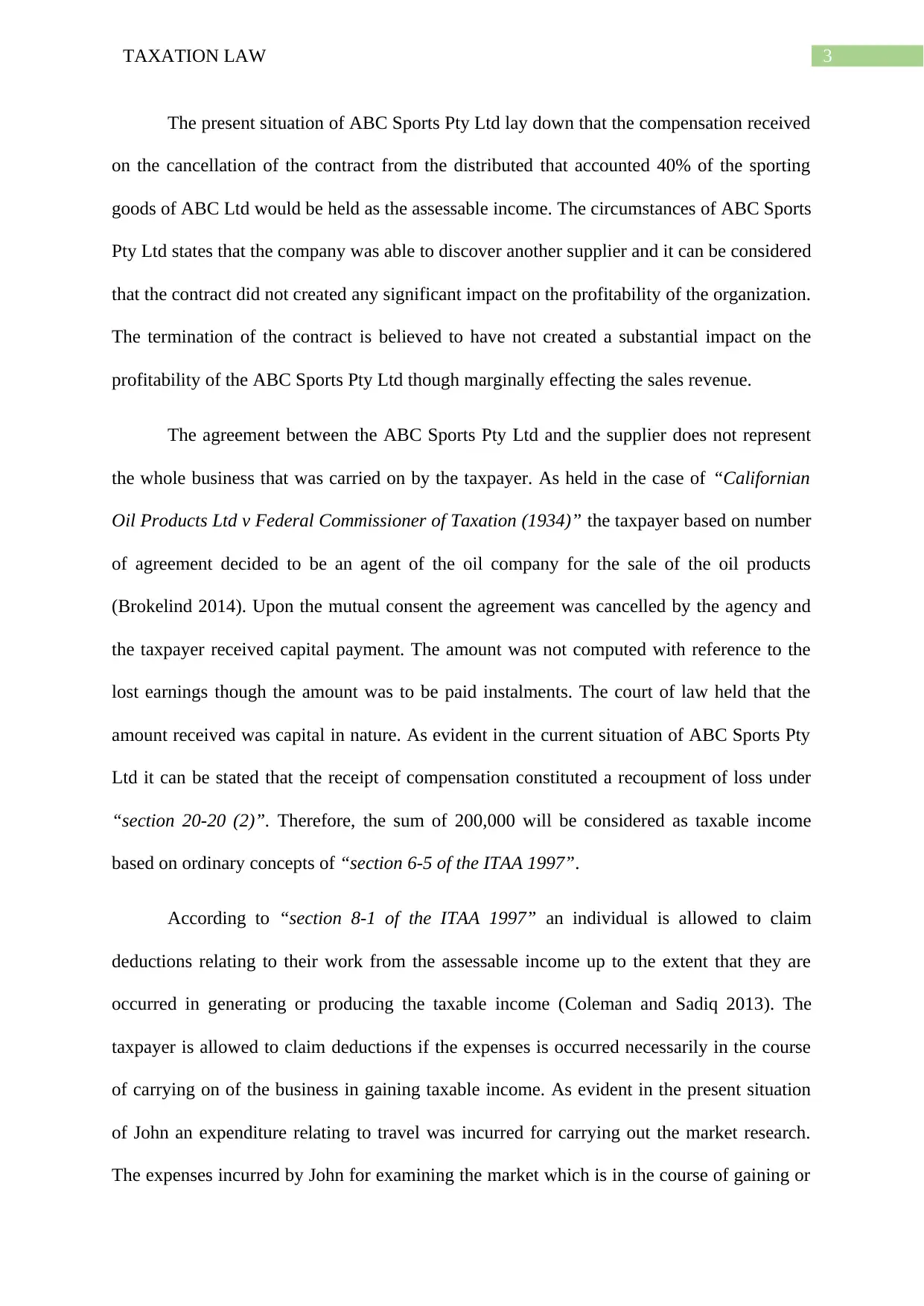
3TAXATION LAW
The present situation of ABC Sports Pty Ltd lay down that the compensation received
on the cancellation of the contract from the distributed that accounted 40% of the sporting
goods of ABC Ltd would be held as the assessable income. The circumstances of ABC Sports
Pty Ltd states that the company was able to discover another supplier and it can be considered
that the contract did not created any significant impact on the profitability of the organization.
The termination of the contract is believed to have not created a substantial impact on the
profitability of the ABC Sports Pty Ltd though marginally effecting the sales revenue.
The agreement between the ABC Sports Pty Ltd and the supplier does not represent
the whole business that was carried on by the taxpayer. As held in the case of “Californian
Oil Products Ltd v Federal Commissioner of Taxation (1934)” the taxpayer based on number
of agreement decided to be an agent of the oil company for the sale of the oil products
(Brokelind 2014). Upon the mutual consent the agreement was cancelled by the agency and
the taxpayer received capital payment. The amount was not computed with reference to the
lost earnings though the amount was to be paid instalments. The court of law held that the
amount received was capital in nature. As evident in the current situation of ABC Sports Pty
Ltd it can be stated that the receipt of compensation constituted a recoupment of loss under
“section 20-20 (2)”. Therefore, the sum of 200,000 will be considered as taxable income
based on ordinary concepts of “section 6-5 of the ITAA 1997”.
According to “section 8-1 of the ITAA 1997” an individual is allowed to claim
deductions relating to their work from the assessable income up to the extent that they are
occurred in generating or producing the taxable income (Coleman and Sadiq 2013). The
taxpayer is allowed to claim deductions if the expenses is occurred necessarily in the course
of carrying on of the business in gaining taxable income. As evident in the present situation
of John an expenditure relating to travel was incurred for carrying out the market research.
The expenses incurred by John for examining the market which is in the course of gaining or
The present situation of ABC Sports Pty Ltd lay down that the compensation received
on the cancellation of the contract from the distributed that accounted 40% of the sporting
goods of ABC Ltd would be held as the assessable income. The circumstances of ABC Sports
Pty Ltd states that the company was able to discover another supplier and it can be considered
that the contract did not created any significant impact on the profitability of the organization.
The termination of the contract is believed to have not created a substantial impact on the
profitability of the ABC Sports Pty Ltd though marginally effecting the sales revenue.
The agreement between the ABC Sports Pty Ltd and the supplier does not represent
the whole business that was carried on by the taxpayer. As held in the case of “Californian
Oil Products Ltd v Federal Commissioner of Taxation (1934)” the taxpayer based on number
of agreement decided to be an agent of the oil company for the sale of the oil products
(Brokelind 2014). Upon the mutual consent the agreement was cancelled by the agency and
the taxpayer received capital payment. The amount was not computed with reference to the
lost earnings though the amount was to be paid instalments. The court of law held that the
amount received was capital in nature. As evident in the current situation of ABC Sports Pty
Ltd it can be stated that the receipt of compensation constituted a recoupment of loss under
“section 20-20 (2)”. Therefore, the sum of 200,000 will be considered as taxable income
based on ordinary concepts of “section 6-5 of the ITAA 1997”.
According to “section 8-1 of the ITAA 1997” an individual is allowed to claim
deductions relating to their work from the assessable income up to the extent that they are
occurred in generating or producing the taxable income (Coleman and Sadiq 2013). The
taxpayer is allowed to claim deductions if the expenses is occurred necessarily in the course
of carrying on of the business in gaining taxable income. As evident in the present situation
of John an expenditure relating to travel was incurred for carrying out the market research.
The expenses incurred by John for examining the market which is in the course of gaining or
Paraphrase This Document
Need a fresh take? Get an instant paraphrase of this document with our AI Paraphraser
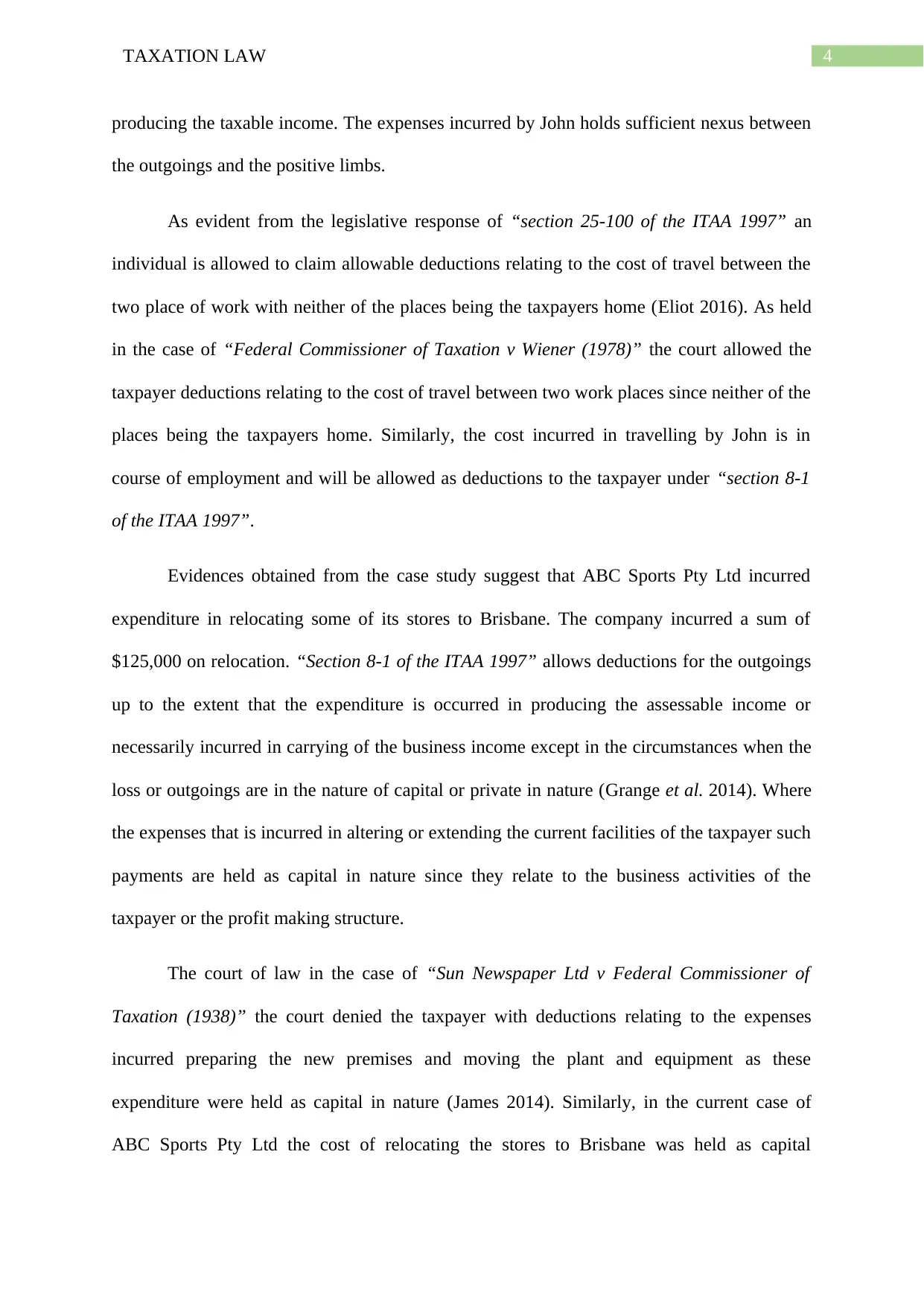
4TAXATION LAW
producing the taxable income. The expenses incurred by John holds sufficient nexus between
the outgoings and the positive limbs.
As evident from the legislative response of “section 25-100 of the ITAA 1997” an
individual is allowed to claim allowable deductions relating to the cost of travel between the
two place of work with neither of the places being the taxpayers home (Eliot 2016). As held
in the case of “Federal Commissioner of Taxation v Wiener (1978)” the court allowed the
taxpayer deductions relating to the cost of travel between two work places since neither of the
places being the taxpayers home. Similarly, the cost incurred in travelling by John is in
course of employment and will be allowed as deductions to the taxpayer under “section 8-1
of the ITAA 1997”.
Evidences obtained from the case study suggest that ABC Sports Pty Ltd incurred
expenditure in relocating some of its stores to Brisbane. The company incurred a sum of
$125,000 on relocation. “Section 8-1 of the ITAA 1997” allows deductions for the outgoings
up to the extent that the expenditure is occurred in producing the assessable income or
necessarily incurred in carrying of the business income except in the circumstances when the
loss or outgoings are in the nature of capital or private in nature (Grange et al. 2014). Where
the expenses that is incurred in altering or extending the current facilities of the taxpayer such
payments are held as capital in nature since they relate to the business activities of the
taxpayer or the profit making structure.
The court of law in the case of “Sun Newspaper Ltd v Federal Commissioner of
Taxation (1938)” the court denied the taxpayer with deductions relating to the expenses
incurred preparing the new premises and moving the plant and equipment as these
expenditure were held as capital in nature (James 2014). Similarly, in the current case of
ABC Sports Pty Ltd the cost of relocating the stores to Brisbane was held as capital
producing the taxable income. The expenses incurred by John holds sufficient nexus between
the outgoings and the positive limbs.
As evident from the legislative response of “section 25-100 of the ITAA 1997” an
individual is allowed to claim allowable deductions relating to the cost of travel between the
two place of work with neither of the places being the taxpayers home (Eliot 2016). As held
in the case of “Federal Commissioner of Taxation v Wiener (1978)” the court allowed the
taxpayer deductions relating to the cost of travel between two work places since neither of the
places being the taxpayers home. Similarly, the cost incurred in travelling by John is in
course of employment and will be allowed as deductions to the taxpayer under “section 8-1
of the ITAA 1997”.
Evidences obtained from the case study suggest that ABC Sports Pty Ltd incurred
expenditure in relocating some of its stores to Brisbane. The company incurred a sum of
$125,000 on relocation. “Section 8-1 of the ITAA 1997” allows deductions for the outgoings
up to the extent that the expenditure is occurred in producing the assessable income or
necessarily incurred in carrying of the business income except in the circumstances when the
loss or outgoings are in the nature of capital or private in nature (Grange et al. 2014). Where
the expenses that is incurred in altering or extending the current facilities of the taxpayer such
payments are held as capital in nature since they relate to the business activities of the
taxpayer or the profit making structure.
The court of law in the case of “Sun Newspaper Ltd v Federal Commissioner of
Taxation (1938)” the court denied the taxpayer with deductions relating to the expenses
incurred preparing the new premises and moving the plant and equipment as these
expenditure were held as capital in nature (James 2014). Similarly, in the current case of
ABC Sports Pty Ltd the cost of relocating the stores to Brisbane was held as capital
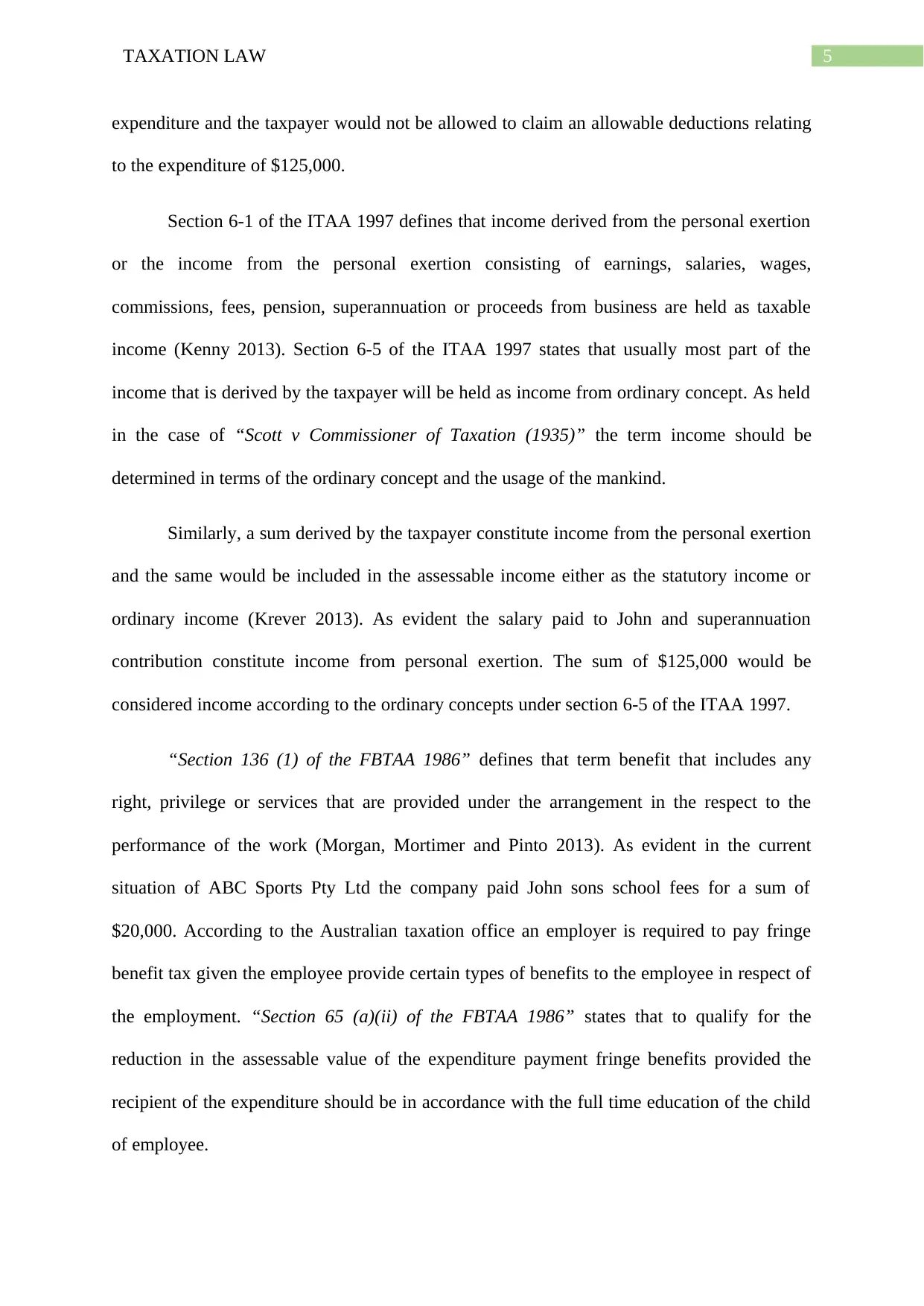
5TAXATION LAW
expenditure and the taxpayer would not be allowed to claim an allowable deductions relating
to the expenditure of $125,000.
Section 6-1 of the ITAA 1997 defines that income derived from the personal exertion
or the income from the personal exertion consisting of earnings, salaries, wages,
commissions, fees, pension, superannuation or proceeds from business are held as taxable
income (Kenny 2013). Section 6-5 of the ITAA 1997 states that usually most part of the
income that is derived by the taxpayer will be held as income from ordinary concept. As held
in the case of “Scott v Commissioner of Taxation (1935)” the term income should be
determined in terms of the ordinary concept and the usage of the mankind.
Similarly, a sum derived by the taxpayer constitute income from the personal exertion
and the same would be included in the assessable income either as the statutory income or
ordinary income (Krever 2013). As evident the salary paid to John and superannuation
contribution constitute income from personal exertion. The sum of $125,000 would be
considered income according to the ordinary concepts under section 6-5 of the ITAA 1997.
“Section 136 (1) of the FBTAA 1986” defines that term benefit that includes any
right, privilege or services that are provided under the arrangement in the respect to the
performance of the work (Morgan, Mortimer and Pinto 2013). As evident in the current
situation of ABC Sports Pty Ltd the company paid John sons school fees for a sum of
$20,000. According to the Australian taxation office an employer is required to pay fringe
benefit tax given the employee provide certain types of benefits to the employee in respect of
the employment. “Section 65 (a)(ii) of the FBTAA 1986” states that to qualify for the
reduction in the assessable value of the expenditure payment fringe benefits provided the
recipient of the expenditure should be in accordance with the full time education of the child
of employee.
expenditure and the taxpayer would not be allowed to claim an allowable deductions relating
to the expenditure of $125,000.
Section 6-1 of the ITAA 1997 defines that income derived from the personal exertion
or the income from the personal exertion consisting of earnings, salaries, wages,
commissions, fees, pension, superannuation or proceeds from business are held as taxable
income (Kenny 2013). Section 6-5 of the ITAA 1997 states that usually most part of the
income that is derived by the taxpayer will be held as income from ordinary concept. As held
in the case of “Scott v Commissioner of Taxation (1935)” the term income should be
determined in terms of the ordinary concept and the usage of the mankind.
Similarly, a sum derived by the taxpayer constitute income from the personal exertion
and the same would be included in the assessable income either as the statutory income or
ordinary income (Krever 2013). As evident the salary paid to John and superannuation
contribution constitute income from personal exertion. The sum of $125,000 would be
considered income according to the ordinary concepts under section 6-5 of the ITAA 1997.
“Section 136 (1) of the FBTAA 1986” defines that term benefit that includes any
right, privilege or services that are provided under the arrangement in the respect to the
performance of the work (Morgan, Mortimer and Pinto 2013). As evident in the current
situation of ABC Sports Pty Ltd the company paid John sons school fees for a sum of
$20,000. According to the Australian taxation office an employer is required to pay fringe
benefit tax given the employee provide certain types of benefits to the employee in respect of
the employment. “Section 65 (a)(ii) of the FBTAA 1986” states that to qualify for the
reduction in the assessable value of the expenditure payment fringe benefits provided the
recipient of the expenditure should be in accordance with the full time education of the child
of employee.
⊘ This is a preview!⊘
Do you want full access?
Subscribe today to unlock all pages.

Trusted by 1+ million students worldwide
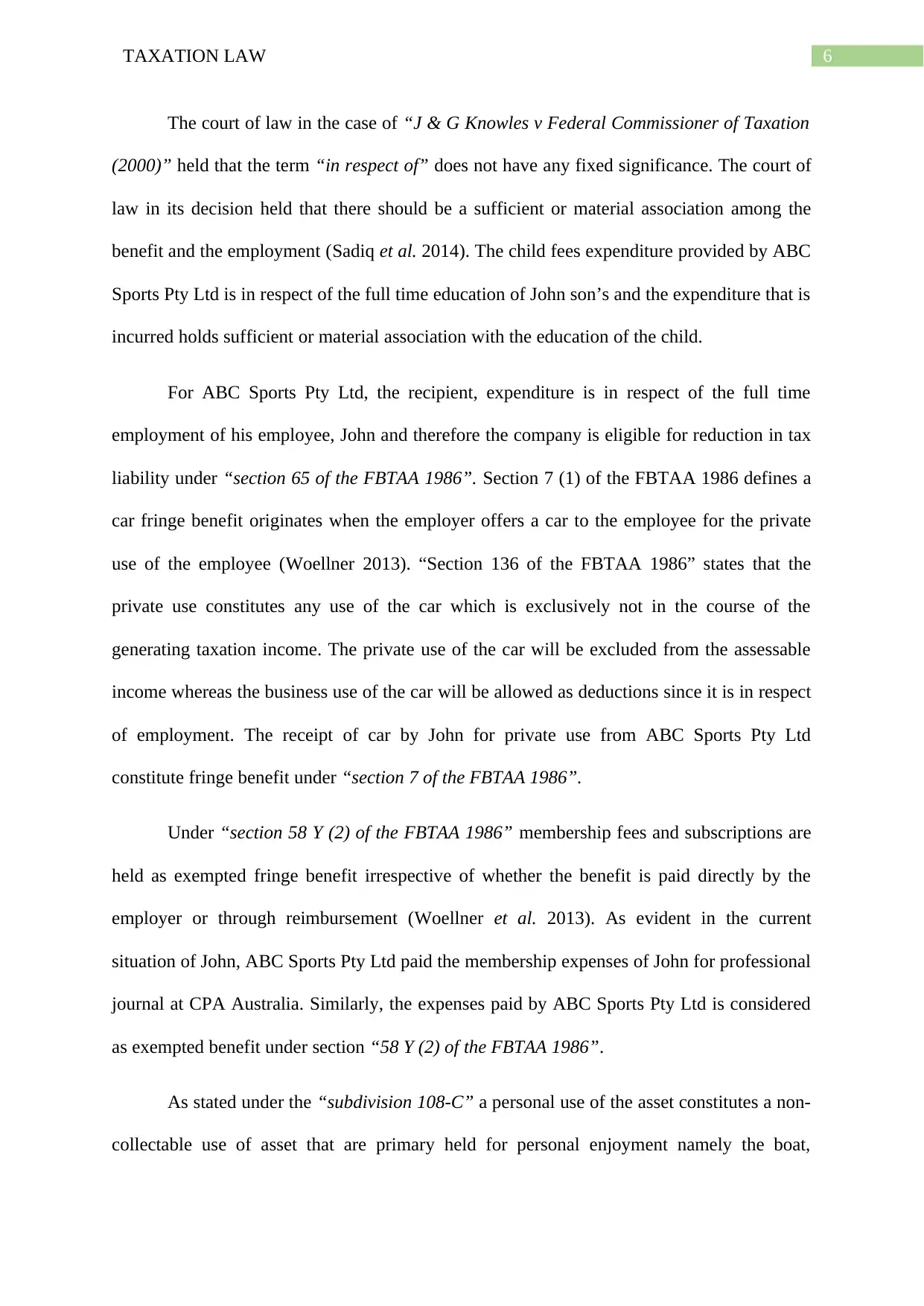
6TAXATION LAW
The court of law in the case of “J & G Knowles v Federal Commissioner of Taxation
(2000)” held that the term “in respect of” does not have any fixed significance. The court of
law in its decision held that there should be a sufficient or material association among the
benefit and the employment (Sadiq et al. 2014). The child fees expenditure provided by ABC
Sports Pty Ltd is in respect of the full time education of John son’s and the expenditure that is
incurred holds sufficient or material association with the education of the child.
For ABC Sports Pty Ltd, the recipient, expenditure is in respect of the full time
employment of his employee, John and therefore the company is eligible for reduction in tax
liability under “section 65 of the FBTAA 1986”. Section 7 (1) of the FBTAA 1986 defines a
car fringe benefit originates when the employer offers a car to the employee for the private
use of the employee (Woellner 2013). “Section 136 of the FBTAA 1986” states that the
private use constitutes any use of the car which is exclusively not in the course of the
generating taxation income. The private use of the car will be excluded from the assessable
income whereas the business use of the car will be allowed as deductions since it is in respect
of employment. The receipt of car by John for private use from ABC Sports Pty Ltd
constitute fringe benefit under “section 7 of the FBTAA 1986”.
Under “section 58 Y (2) of the FBTAA 1986” membership fees and subscriptions are
held as exempted fringe benefit irrespective of whether the benefit is paid directly by the
employer or through reimbursement (Woellner et al. 2013). As evident in the current
situation of John, ABC Sports Pty Ltd paid the membership expenses of John for professional
journal at CPA Australia. Similarly, the expenses paid by ABC Sports Pty Ltd is considered
as exempted benefit under section “58 Y (2) of the FBTAA 1986”.
As stated under the “subdivision 108-C” a personal use of the asset constitutes a non-
collectable use of asset that are primary held for personal enjoyment namely the boat,
The court of law in the case of “J & G Knowles v Federal Commissioner of Taxation
(2000)” held that the term “in respect of” does not have any fixed significance. The court of
law in its decision held that there should be a sufficient or material association among the
benefit and the employment (Sadiq et al. 2014). The child fees expenditure provided by ABC
Sports Pty Ltd is in respect of the full time education of John son’s and the expenditure that is
incurred holds sufficient or material association with the education of the child.
For ABC Sports Pty Ltd, the recipient, expenditure is in respect of the full time
employment of his employee, John and therefore the company is eligible for reduction in tax
liability under “section 65 of the FBTAA 1986”. Section 7 (1) of the FBTAA 1986 defines a
car fringe benefit originates when the employer offers a car to the employee for the private
use of the employee (Woellner 2013). “Section 136 of the FBTAA 1986” states that the
private use constitutes any use of the car which is exclusively not in the course of the
generating taxation income. The private use of the car will be excluded from the assessable
income whereas the business use of the car will be allowed as deductions since it is in respect
of employment. The receipt of car by John for private use from ABC Sports Pty Ltd
constitute fringe benefit under “section 7 of the FBTAA 1986”.
Under “section 58 Y (2) of the FBTAA 1986” membership fees and subscriptions are
held as exempted fringe benefit irrespective of whether the benefit is paid directly by the
employer or through reimbursement (Woellner et al. 2013). As evident in the current
situation of John, ABC Sports Pty Ltd paid the membership expenses of John for professional
journal at CPA Australia. Similarly, the expenses paid by ABC Sports Pty Ltd is considered
as exempted benefit under section “58 Y (2) of the FBTAA 1986”.
As stated under the “subdivision 108-C” a personal use of the asset constitutes a non-
collectable use of asset that are primary held for personal enjoyment namely the boat,
Paraphrase This Document
Need a fresh take? Get an instant paraphrase of this document with our AI Paraphraser
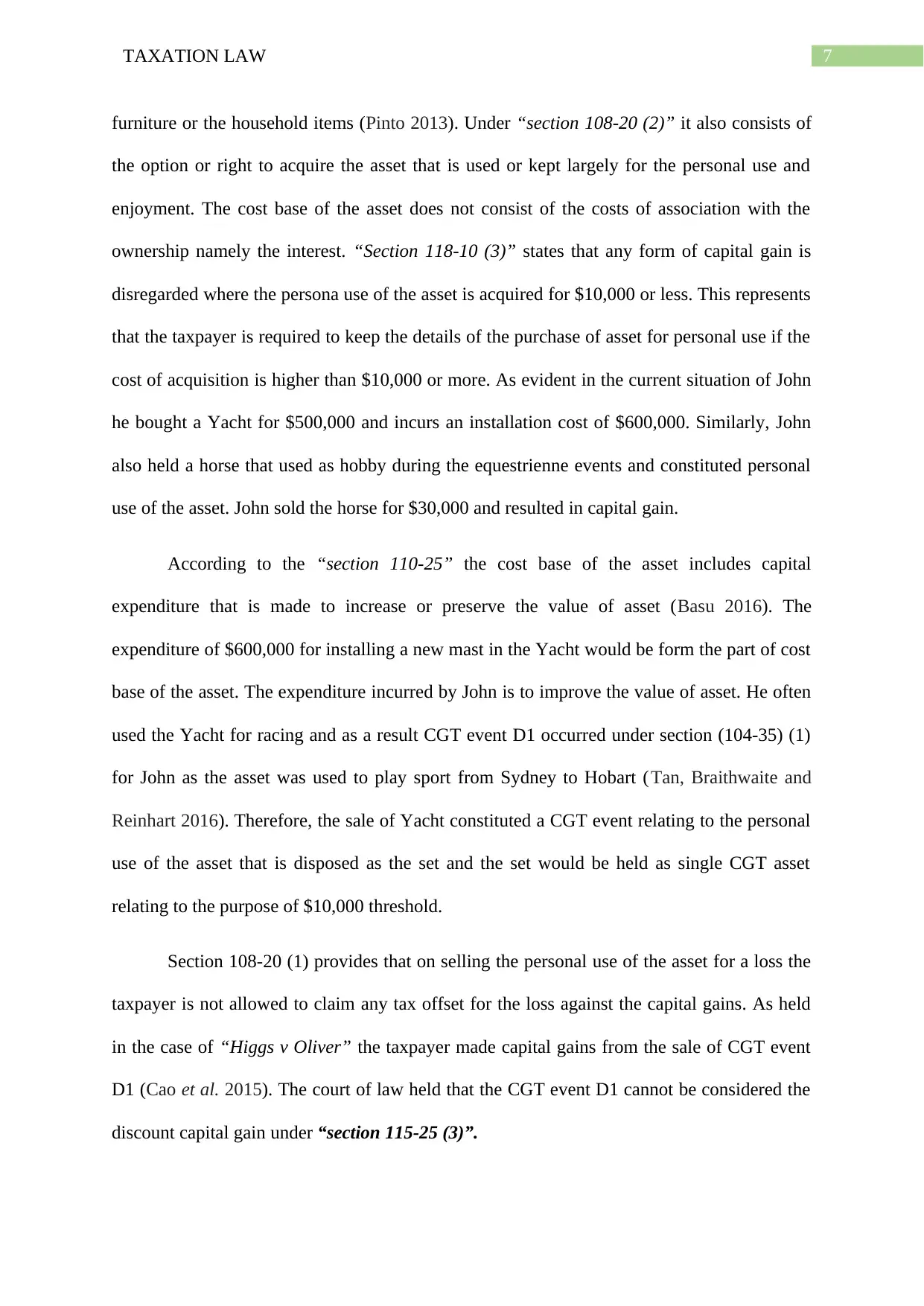
7TAXATION LAW
furniture or the household items (Pinto 2013). Under “section 108-20 (2)” it also consists of
the option or right to acquire the asset that is used or kept largely for the personal use and
enjoyment. The cost base of the asset does not consist of the costs of association with the
ownership namely the interest. “Section 118-10 (3)” states that any form of capital gain is
disregarded where the persona use of the asset is acquired for $10,000 or less. This represents
that the taxpayer is required to keep the details of the purchase of asset for personal use if the
cost of acquisition is higher than $10,000 or more. As evident in the current situation of John
he bought a Yacht for $500,000 and incurs an installation cost of $600,000. Similarly, John
also held a horse that used as hobby during the equestrienne events and constituted personal
use of the asset. John sold the horse for $30,000 and resulted in capital gain.
According to the “section 110-25” the cost base of the asset includes capital
expenditure that is made to increase or preserve the value of asset (Basu 2016). The
expenditure of $600,000 for installing a new mast in the Yacht would be form the part of cost
base of the asset. The expenditure incurred by John is to improve the value of asset. He often
used the Yacht for racing and as a result CGT event D1 occurred under section (104-35) (1)
for John as the asset was used to play sport from Sydney to Hobart (Tan, Braithwaite and
Reinhart 2016). Therefore, the sale of Yacht constituted a CGT event relating to the personal
use of the asset that is disposed as the set and the set would be held as single CGT asset
relating to the purpose of $10,000 threshold.
Section 108-20 (1) provides that on selling the personal use of the asset for a loss the
taxpayer is not allowed to claim any tax offset for the loss against the capital gains. As held
in the case of “Higgs v Oliver” the taxpayer made capital gains from the sale of CGT event
D1 (Cao et al. 2015). The court of law held that the CGT event D1 cannot be considered the
discount capital gain under “section 115-25 (3)”.
furniture or the household items (Pinto 2013). Under “section 108-20 (2)” it also consists of
the option or right to acquire the asset that is used or kept largely for the personal use and
enjoyment. The cost base of the asset does not consist of the costs of association with the
ownership namely the interest. “Section 118-10 (3)” states that any form of capital gain is
disregarded where the persona use of the asset is acquired for $10,000 or less. This represents
that the taxpayer is required to keep the details of the purchase of asset for personal use if the
cost of acquisition is higher than $10,000 or more. As evident in the current situation of John
he bought a Yacht for $500,000 and incurs an installation cost of $600,000. Similarly, John
also held a horse that used as hobby during the equestrienne events and constituted personal
use of the asset. John sold the horse for $30,000 and resulted in capital gain.
According to the “section 110-25” the cost base of the asset includes capital
expenditure that is made to increase or preserve the value of asset (Basu 2016). The
expenditure of $600,000 for installing a new mast in the Yacht would be form the part of cost
base of the asset. The expenditure incurred by John is to improve the value of asset. He often
used the Yacht for racing and as a result CGT event D1 occurred under section (104-35) (1)
for John as the asset was used to play sport from Sydney to Hobart (Tan, Braithwaite and
Reinhart 2016). Therefore, the sale of Yacht constituted a CGT event relating to the personal
use of the asset that is disposed as the set and the set would be held as single CGT asset
relating to the purpose of $10,000 threshold.
Section 108-20 (1) provides that on selling the personal use of the asset for a loss the
taxpayer is not allowed to claim any tax offset for the loss against the capital gains. As held
in the case of “Higgs v Oliver” the taxpayer made capital gains from the sale of CGT event
D1 (Cao et al. 2015). The court of law held that the CGT event D1 cannot be considered the
discount capital gain under “section 115-25 (3)”.
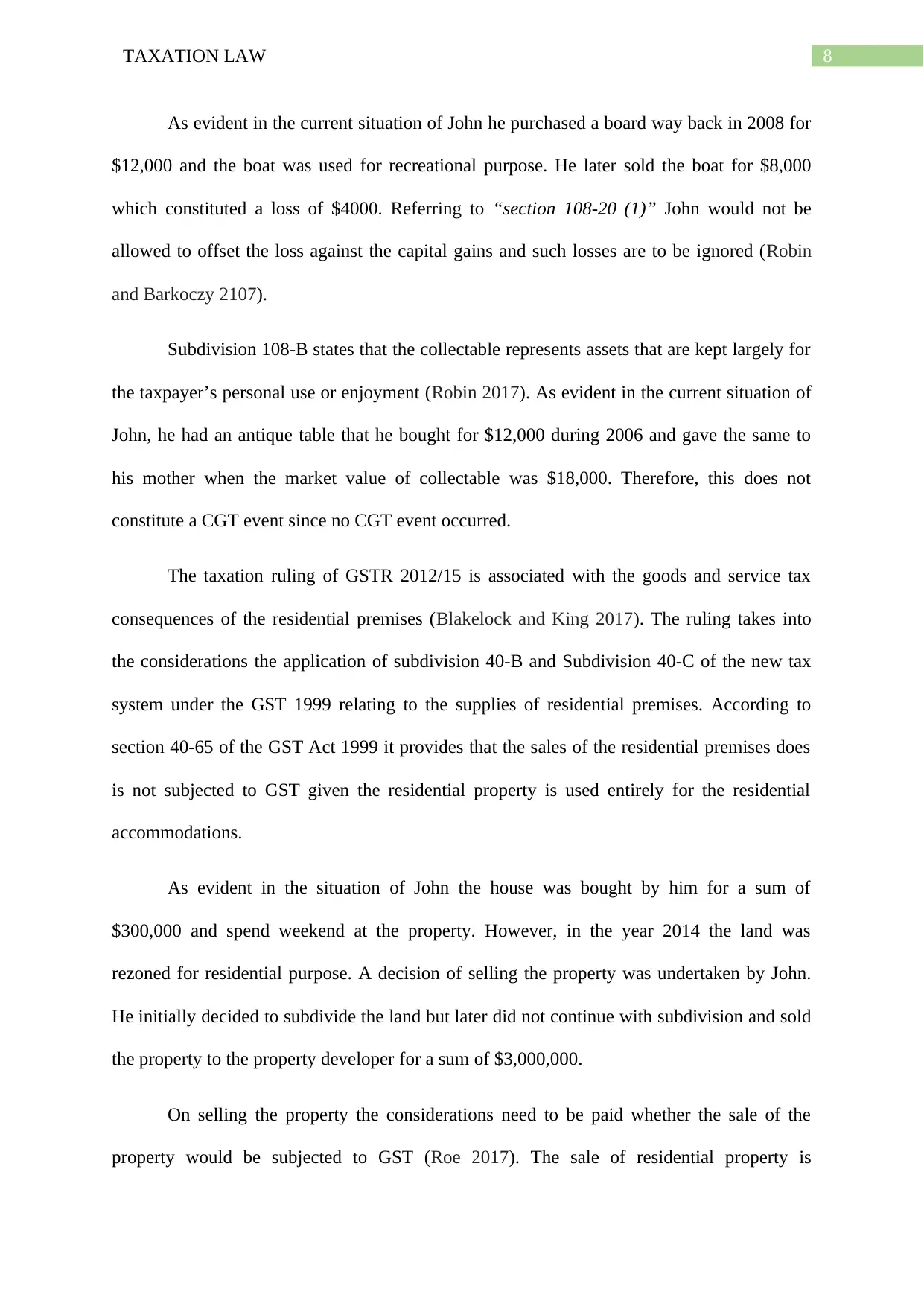
8TAXATION LAW
As evident in the current situation of John he purchased a board way back in 2008 for
$12,000 and the boat was used for recreational purpose. He later sold the boat for $8,000
which constituted a loss of $4000. Referring to “section 108-20 (1)” John would not be
allowed to offset the loss against the capital gains and such losses are to be ignored (Robin
and Barkoczy 2107).
Subdivision 108-B states that the collectable represents assets that are kept largely for
the taxpayer’s personal use or enjoyment (Robin 2017). As evident in the current situation of
John, he had an antique table that he bought for $12,000 during 2006 and gave the same to
his mother when the market value of collectable was $18,000. Therefore, this does not
constitute a CGT event since no CGT event occurred.
The taxation ruling of GSTR 2012/15 is associated with the goods and service tax
consequences of the residential premises (Blakelock and King 2017). The ruling takes into
the considerations the application of subdivision 40-B and Subdivision 40-C of the new tax
system under the GST 1999 relating to the supplies of residential premises. According to
section 40-65 of the GST Act 1999 it provides that the sales of the residential premises does
is not subjected to GST given the residential property is used entirely for the residential
accommodations.
As evident in the situation of John the house was bought by him for a sum of
$300,000 and spend weekend at the property. However, in the year 2014 the land was
rezoned for residential purpose. A decision of selling the property was undertaken by John.
He initially decided to subdivide the land but later did not continue with subdivision and sold
the property to the property developer for a sum of $3,000,000.
On selling the property the considerations need to be paid whether the sale of the
property would be subjected to GST (Roe 2017). The sale of residential property is
As evident in the current situation of John he purchased a board way back in 2008 for
$12,000 and the boat was used for recreational purpose. He later sold the boat for $8,000
which constituted a loss of $4000. Referring to “section 108-20 (1)” John would not be
allowed to offset the loss against the capital gains and such losses are to be ignored (Robin
and Barkoczy 2107).
Subdivision 108-B states that the collectable represents assets that are kept largely for
the taxpayer’s personal use or enjoyment (Robin 2017). As evident in the current situation of
John, he had an antique table that he bought for $12,000 during 2006 and gave the same to
his mother when the market value of collectable was $18,000. Therefore, this does not
constitute a CGT event since no CGT event occurred.
The taxation ruling of GSTR 2012/15 is associated with the goods and service tax
consequences of the residential premises (Blakelock and King 2017). The ruling takes into
the considerations the application of subdivision 40-B and Subdivision 40-C of the new tax
system under the GST 1999 relating to the supplies of residential premises. According to
section 40-65 of the GST Act 1999 it provides that the sales of the residential premises does
is not subjected to GST given the residential property is used entirely for the residential
accommodations.
As evident in the situation of John the house was bought by him for a sum of
$300,000 and spend weekend at the property. However, in the year 2014 the land was
rezoned for residential purpose. A decision of selling the property was undertaken by John.
He initially decided to subdivide the land but later did not continue with subdivision and sold
the property to the property developer for a sum of $3,000,000.
On selling the property the considerations need to be paid whether the sale of the
property would be subjected to GST (Roe 2017). The sale of residential property is
⊘ This is a preview!⊘
Do you want full access?
Subscribe today to unlock all pages.

Trusted by 1+ million students worldwide
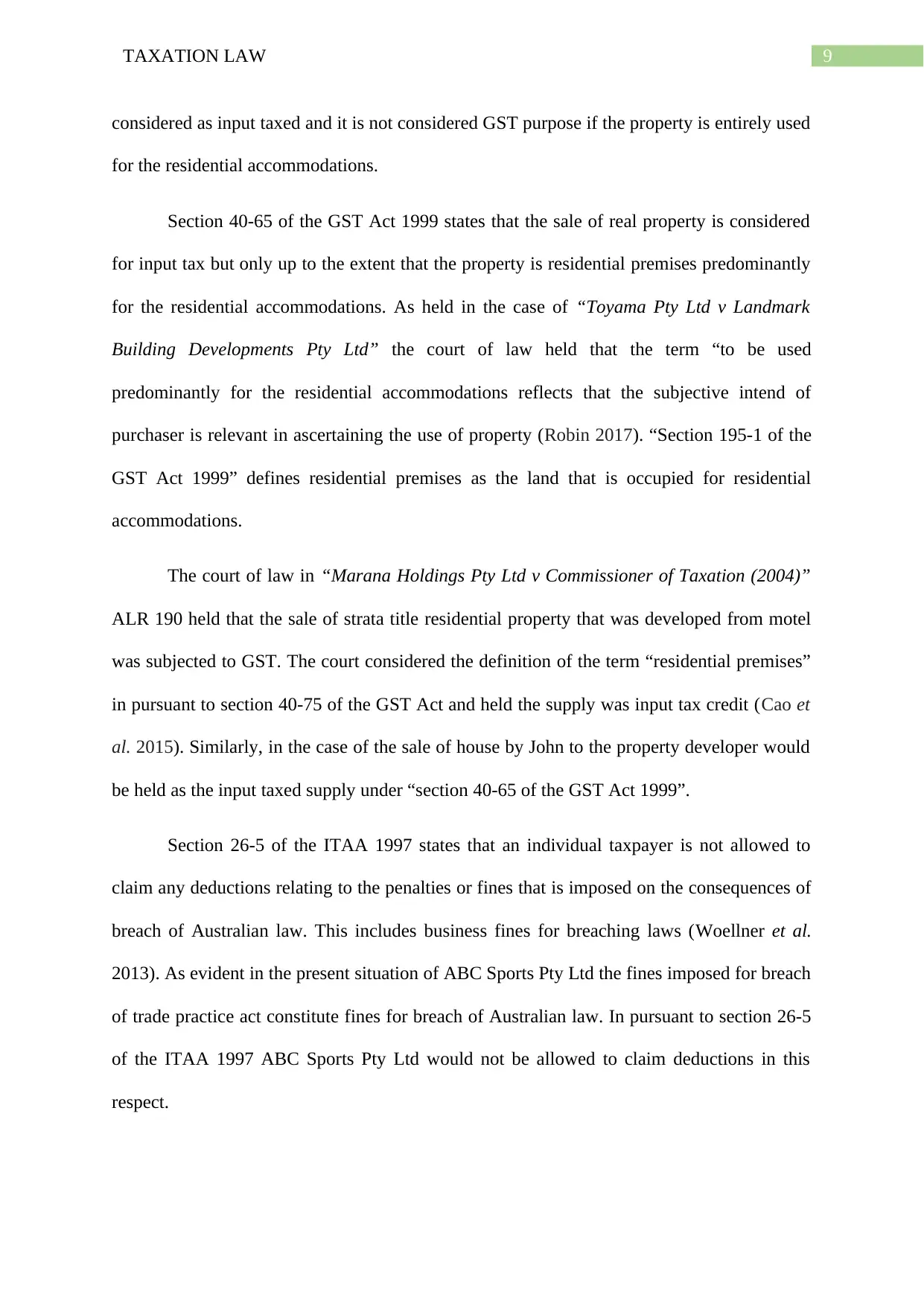
9TAXATION LAW
considered as input taxed and it is not considered GST purpose if the property is entirely used
for the residential accommodations.
Section 40-65 of the GST Act 1999 states that the sale of real property is considered
for input tax but only up to the extent that the property is residential premises predominantly
for the residential accommodations. As held in the case of “Toyama Pty Ltd v Landmark
Building Developments Pty Ltd” the court of law held that the term “to be used
predominantly for the residential accommodations reflects that the subjective intend of
purchaser is relevant in ascertaining the use of property (Robin 2017). “Section 195-1 of the
GST Act 1999” defines residential premises as the land that is occupied for residential
accommodations.
The court of law in “Marana Holdings Pty Ltd v Commissioner of Taxation (2004)”
ALR 190 held that the sale of strata title residential property that was developed from motel
was subjected to GST. The court considered the definition of the term “residential premises”
in pursuant to section 40-75 of the GST Act and held the supply was input tax credit (Cao et
al. 2015). Similarly, in the case of the sale of house by John to the property developer would
be held as the input taxed supply under “section 40-65 of the GST Act 1999”.
Section 26-5 of the ITAA 1997 states that an individual taxpayer is not allowed to
claim any deductions relating to the penalties or fines that is imposed on the consequences of
breach of Australian law. This includes business fines for breaching laws (Woellner et al.
2013). As evident in the present situation of ABC Sports Pty Ltd the fines imposed for breach
of trade practice act constitute fines for breach of Australian law. In pursuant to section 26-5
of the ITAA 1997 ABC Sports Pty Ltd would not be allowed to claim deductions in this
respect.
considered as input taxed and it is not considered GST purpose if the property is entirely used
for the residential accommodations.
Section 40-65 of the GST Act 1999 states that the sale of real property is considered
for input tax but only up to the extent that the property is residential premises predominantly
for the residential accommodations. As held in the case of “Toyama Pty Ltd v Landmark
Building Developments Pty Ltd” the court of law held that the term “to be used
predominantly for the residential accommodations reflects that the subjective intend of
purchaser is relevant in ascertaining the use of property (Robin 2017). “Section 195-1 of the
GST Act 1999” defines residential premises as the land that is occupied for residential
accommodations.
The court of law in “Marana Holdings Pty Ltd v Commissioner of Taxation (2004)”
ALR 190 held that the sale of strata title residential property that was developed from motel
was subjected to GST. The court considered the definition of the term “residential premises”
in pursuant to section 40-75 of the GST Act and held the supply was input tax credit (Cao et
al. 2015). Similarly, in the case of the sale of house by John to the property developer would
be held as the input taxed supply under “section 40-65 of the GST Act 1999”.
Section 26-5 of the ITAA 1997 states that an individual taxpayer is not allowed to
claim any deductions relating to the penalties or fines that is imposed on the consequences of
breach of Australian law. This includes business fines for breaching laws (Woellner et al.
2013). As evident in the present situation of ABC Sports Pty Ltd the fines imposed for breach
of trade practice act constitute fines for breach of Australian law. In pursuant to section 26-5
of the ITAA 1997 ABC Sports Pty Ltd would not be allowed to claim deductions in this
respect.
Paraphrase This Document
Need a fresh take? Get an instant paraphrase of this document with our AI Paraphraser
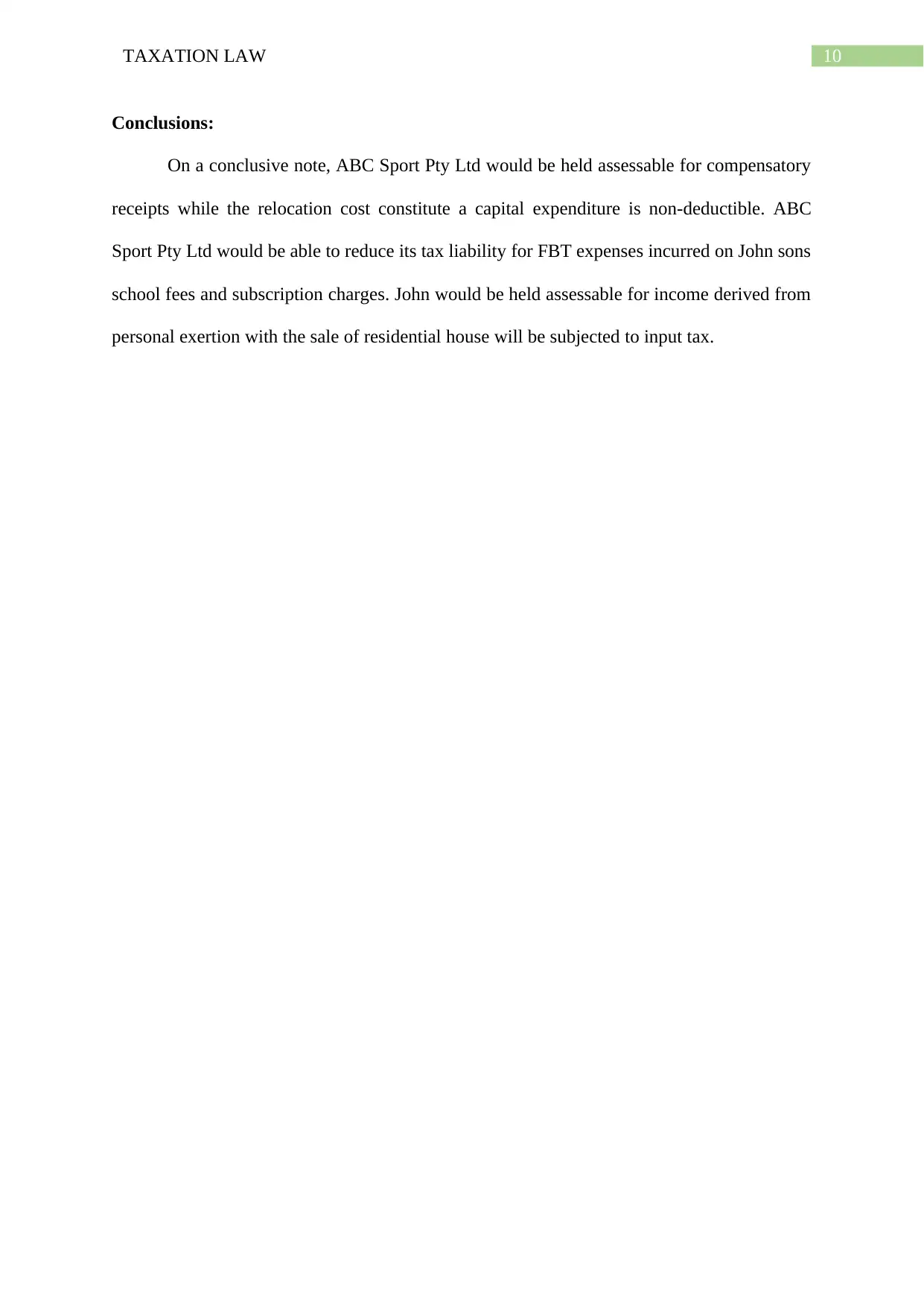
10TAXATION LAW
Conclusions:
On a conclusive note, ABC Sport Pty Ltd would be held assessable for compensatory
receipts while the relocation cost constitute a capital expenditure is non-deductible. ABC
Sport Pty Ltd would be able to reduce its tax liability for FBT expenses incurred on John sons
school fees and subscription charges. John would be held assessable for income derived from
personal exertion with the sale of residential house will be subjected to input tax.
Conclusions:
On a conclusive note, ABC Sport Pty Ltd would be held assessable for compensatory
receipts while the relocation cost constitute a capital expenditure is non-deductible. ABC
Sport Pty Ltd would be able to reduce its tax liability for FBT expenses incurred on John sons
school fees and subscription charges. John would be held assessable for income derived from
personal exertion with the sale of residential house will be subjected to input tax.
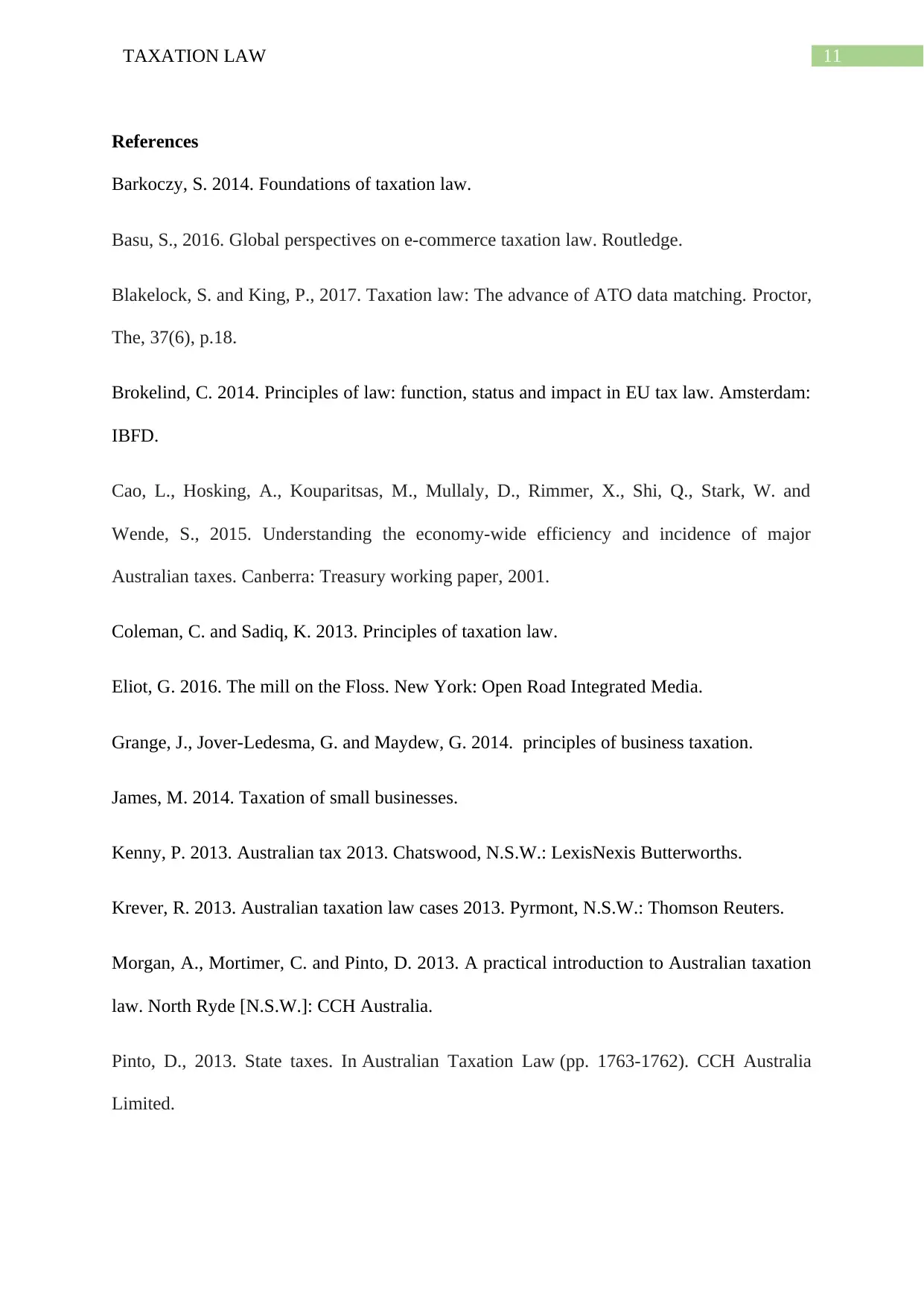
11TAXATION LAW
References
Barkoczy, S. 2014. Foundations of taxation law.
Basu, S., 2016. Global perspectives on e-commerce taxation law. Routledge.
Blakelock, S. and King, P., 2017. Taxation law: The advance of ATO data matching. Proctor,
The, 37(6), p.18.
Brokelind, C. 2014. Principles of law: function, status and impact in EU tax law. Amsterdam:
IBFD.
Cao, L., Hosking, A., Kouparitsas, M., Mullaly, D., Rimmer, X., Shi, Q., Stark, W. and
Wende, S., 2015. Understanding the economy-wide efficiency and incidence of major
Australian taxes. Canberra: Treasury working paper, 2001.
Coleman, C. and Sadiq, K. 2013. Principles of taxation law.
Eliot, G. 2016. The mill on the Floss. New York: Open Road Integrated Media.
Grange, J., Jover-Ledesma, G. and Maydew, G. 2014. principles of business taxation.
James, M. 2014. Taxation of small businesses.
Kenny, P. 2013. Australian tax 2013. Chatswood, N.S.W.: LexisNexis Butterworths.
Krever, R. 2013. Australian taxation law cases 2013. Pyrmont, N.S.W.: Thomson Reuters.
Morgan, A., Mortimer, C. and Pinto, D. 2013. A practical introduction to Australian taxation
law. North Ryde [N.S.W.]: CCH Australia.
Pinto, D., 2013. State taxes. In Australian Taxation Law (pp. 1763-1762). CCH Australia
Limited.
References
Barkoczy, S. 2014. Foundations of taxation law.
Basu, S., 2016. Global perspectives on e-commerce taxation law. Routledge.
Blakelock, S. and King, P., 2017. Taxation law: The advance of ATO data matching. Proctor,
The, 37(6), p.18.
Brokelind, C. 2014. Principles of law: function, status and impact in EU tax law. Amsterdam:
IBFD.
Cao, L., Hosking, A., Kouparitsas, M., Mullaly, D., Rimmer, X., Shi, Q., Stark, W. and
Wende, S., 2015. Understanding the economy-wide efficiency and incidence of major
Australian taxes. Canberra: Treasury working paper, 2001.
Coleman, C. and Sadiq, K. 2013. Principles of taxation law.
Eliot, G. 2016. The mill on the Floss. New York: Open Road Integrated Media.
Grange, J., Jover-Ledesma, G. and Maydew, G. 2014. principles of business taxation.
James, M. 2014. Taxation of small businesses.
Kenny, P. 2013. Australian tax 2013. Chatswood, N.S.W.: LexisNexis Butterworths.
Krever, R. 2013. Australian taxation law cases 2013. Pyrmont, N.S.W.: Thomson Reuters.
Morgan, A., Mortimer, C. and Pinto, D. 2013. A practical introduction to Australian taxation
law. North Ryde [N.S.W.]: CCH Australia.
Pinto, D., 2013. State taxes. In Australian Taxation Law (pp. 1763-1762). CCH Australia
Limited.
⊘ This is a preview!⊘
Do you want full access?
Subscribe today to unlock all pages.

Trusted by 1+ million students worldwide
1 out of 13
Related Documents
Your All-in-One AI-Powered Toolkit for Academic Success.
+13062052269
info@desklib.com
Available 24*7 on WhatsApp / Email
![[object Object]](/_next/static/media/star-bottom.7253800d.svg)
Unlock your academic potential
Copyright © 2020–2025 A2Z Services. All Rights Reserved. Developed and managed by ZUCOL.





